Xi'an SightseeingAn old saying in China tells the unique position of this legendary city: "If you want to see China of 100 years ago, visit Shanghai; China of 500 years ago, Beijing; China of 2000 years ago, Xi'an". As the cradle of Chinese culture, the city was capital to the first dynasty of China, and also many of its successors. The position as the cultural and political center of the country has left the city with a great heritage, whose physical and spiritual evidence still dominates the ancient city. Only historical landmarks are highlighted in Xi'an due to its ancient importance.
The Terra Cotta Warriors and Horses are the most significant archeological excavations of the 20th century. The Mausoleum of Qin Shi Huang and his Terracotta Army are located 40 kilometers to the east of the city's suburbs. For 2000 years, a secret army of clay soldiers protected the hidden tomb of China's first emperor, Qin Shi Huang. Until 1974 none knew of its existence; now Chinese archaeologists are gradually unfolding the mystery. Qin Shi Huang was buried in his mausoleum, with the famous Terracotta Army, near modern day Xi'an, Shaanxi Province.To guard him in his afterlife the emperor ordered an army of over 8000 life size clay soldiers to be made. When he died, the burial place was as magnificent and bizarre as the treasure laden tombs of the Egyptian pharaohs. The site measures some three miles across and took 700,000 conscripts to construct it. Many wonders of the tomb were described by a Chinese historian, Sima Qian, writing less than a century after the emperor's death. He wrote of rare jewels, a map of the heavens with stars represented by pearls, and, on the floor of the tomb, a panorama map of China with the rivers and seas represented by flowing mercury. The mound itself was said to have been coated with molten copper to protect it, with crossbows lined up to shoot anyone who tried to break in. All the standing warriors were attached to clay plinths that rested on the tiled floor, which still resembles a modern pavement. The soldiers were arranged in battle formation, with 600 clay horses and 100 life-sized working wooden chariots. The main tomb containing the emperor has yet to be opened and there is still hope that it remains intact. It is said that molten copper was used to seal it. A magnetic scan of the site has revealed that a large number of coins are lying in the unopened tomb, occasioning speculation that the royal treasury was interred with the emperor. Scans of the earth atop the tomb have revealed unusually high concentrations of mercury in the shape of China's waters, adding further to the credibility of Sima Qian's description.
In 221 BC, Emperor Qin Shi Huang of the Qin dynasty was in search of immortality, and ordered the construction of a vast army of 8,000 life-sized Terra Cotta warriors to be buried with him in order to protect his empire after his early death. In 1974, when some peasants were digging a well, they made the discovery of the Terra-Cotta Warriors and Horse. This oblong shaped pit is 689 feet long, 197 feet wide. The trenches that contain the soldiers are 14.8 to 21.3 feet deep. The actual bodies of the soldiers were formed out of terra cotta clay. Each soldier was baked in a kiln. The positioning of the soldiers in the oblong shape shows an actual battle formation of the troops. These warriors were dressed and ready for battle. They carried spears and various other combat weapons. Each warrior wore an army uniform painted either red or green and either brown or black armor, which distinguishes the soldier's rank. There are four main categories of figures: chariot warriors, infantrymen, cavalrymen, and horses. There are generals, middle ranking officers, lower ranking officers, ordinary soldiers, and armored warriors. The latter can be further divided according to their headgear into warriors with a square scarf, a cylindrical bun, or a flat bun. There are kneeling warriors as well. The height of the normal soldiers ranges from 5 ft. 8 in. to 6 ft. 2.5 in. Those that rode the chariots were 6 ft. 2.5 in. The commanders were the tallest out of all the soldiers. They stood 6 ft. 5 in. Clearly height represented the importance of the officer. The second excavation occurred in May of 1976. This pit contains 1,400 warriors with horses. It is 64,000 square feet in area. Pit number two differs greatly from the first pit. The battle formation was square. This pit contains sixty-four chariots. It has divided groups which include infantrymen, cavalrymen and even commanders to guide the troops. This display of soldiers gives insight into the work that went into the Chinese army. Long distance battles had to be fought by using many chariots. The facial expressions of the men in this pit are also very different from those men in the first pit. The third pit was then discovered in 1980. This pit is the smallest out of the three discovered. It contains only one chariot, six warriors, and a small amount of weapons. This room is thought to be a group of special commanders. A fourth pit was also discovered, however it came out to be bare. This room is probably empty because the workers did not complete the warriors in time for Qin's death. Mausoleum and Terra-Cotta Warriors

The Big Wild Goose Pagoda, one of the main constructions in the famous Buddhist temple-Da-Ci-En Temple is situated at south of the Xi'an city. The pagoda is one of the most distinctive and outstanding landmarks for Xi'an. It is sturdy and angular, square in plan, and more than 60m tall. It has been restored and added to many times, though the current design is not far from the original. On the first floor is an exhibition of different pagoda styles, and, at either side of the south entrance, stone tablets hold calligraphy by two Tang emperors, surrounded by dragon and flying angels. Over the lintel of the west door is a fine Tang carving of Buddha and his disciples sitting in a Chinese building. The pagoda has seven stories, each with large windows out of which visitors throw money for luck. The view from the north window is the most impressive for the rigorous geometry of the streets below, though it is hard to believe that when built the temple was at least 3km inside the Tang city.
This is the largest temple in Xi'an, though when it was established in 647 AD it was much larger, with nearly two thousand rooms, and a resident population of more than three thousand monks. The original was destroyed in 907 AD, and the present buildings are Qing. Other rooms hold shops ad exhibitions of paintings. All around the temple you will see rubbings from a Qing stele in the Xingjiao Si of images of Tang dynasty monk Xuan Zang, the temple's most famous resident, who spent fifteen years collecting Sanskrit sutras in India before translating them here in 1335 volumes.
For centuries emperors came to the hot springs to bathe and enjoy the scenic beauty, and it has been a favorite spa since the Tang Dynasty. The Tang Emperor Xuanzong often spent the winter here in the company of his favorite concubine, Yang Guifei. Shortly afterwards, however, all the buildings were destroyed by war. The new baths constructed in 1956 include one called the Bath of Yang Guifei (Guifei - Honorable Concubine).
To the northwest of the Bell Tower is the Drum Tower, another symbol of ancient Xi'an, which stands on the diagonal of the Bell Tower and Drum Tower Square. Four years older than the Bell Tower, the Drum Tower was also built during the Ming Dynasty. A huge drum was housed in the tower and struck every evening.
First construction of the first city wall of Chang'an began in 194 BC and lasted for four years. Rebuilding of the wall began 650 years ago in the Ming Dynasty in 1370, where the new Wall was added onto the Tang Dynasty walls. Being the most prominent of walls built after medieval time, it is also the best-kept and biggest city walls in China. It stands approximately 12 meters high, about 12 to 14 meters across the top, 15 to 18 meters thick at bottom and 13.7 kilometers in length. From the top, you can easily see the ancient and the modern, side by side. It is the best preserved, oldest and largest ancient city defense system in China. It is also one of the most important landmarks in Xi'an city.
After his death in 1925, Mrs. Soong continued to live here until 1937 when the Japanese army occupied Shanghai. Eight years later, upon China winning the war, Mrs. Soong offered to provide her home as the permanent site to Dr. Sun's memory. In 1961, the Former Residence of Sun Yat-sen was listed as being one of the key state preserved by the Cultural Relic Unit. Today, the former residence of Sun Yat Sen became a tourist destination. Visitors can enter through the kitchen on the way to the dining room. Sun's study is upstairs, complete with ink stone, brushes, maps drawn by Dr. Sun, and a library of 2,700 volumes. The bedroom and the drawing room contain more original furnishings, including an original "Zhongshan" suit, similar to the later Mao suit. The backyard has a charming garden. Address: 7 Xiangshan Lu, west of Fuxing Park at Sinan Lu, Luwan,
Shanghai
SteleForest is a museum for steles and stone sculptures which is located in Xi'an, China. Its name comes from its huge collection of steles, reminiscent of a forest. The Stele Forest is famous for its numerous historic inscriptions and stoneworks. The Stele Forest began with the Kaicheng Shi Jing Steles and Shitai Xiao Jing Steles, two groups of steles both carved in the Tang dynasty and displayed in the temple to Confucius in Chang'an. In 904 AD, a rebel army sacked Chang'an, and the two stele were evacuated to the inner city. In 962 AD, they were again moved to the rebuilt temple to Confucius. In the Song Dynasty (1087), a special hall, with attached facilities, was built to house and display the two Stele groups. It was damaged during the Ming dynasty, in the 1556 Shaanxi earthquake. Stele collects nearly 3000 steles and it is the biggest museum for steles in China. Most of its collections are steles of the Tang Dynasty. Ink rubbings of the steles are available for sale. Among the unusual examples is an 18th-century stele depicting a Yangtze River flood control project. Another appears to be a bamboo forest, but on examination the leaves and branches form a poem.
The settlement was surrounded by a moat, with the graves and pottery kilns located outside of the moat perimeter. Many of the houses were semi-subterranean with the floor typically a meter below the ground surface. The houses were supported by timber poles and had steeply pitched thatched roofs. According to the Marxist paradigm of archaeology that was prevalent in the People's Republic of China during the time of the excavation of the site, Banpo was considered to be a matriarchal society; however, new research contradicts this claim, and the Marxist paradigm is gradually being phased out in modern Chinese archaeological research. The site is now home to the Xi'an Banpo Museum.
Thousands of steps have been cut into the rock in order to facilitate ascending and descending. Many pilgrims tie red strips or lock locks to various locations near the summits for some sort of religious purpose. NOTE: Although this information is correct at the time of our web publication, it is still advised that you call the phone number and confirm the address before going to the venue because some venues may have changed their telephone numbers or address locations.
|

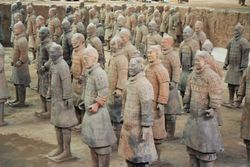 No two terracotta soldiers are identical. The sculptures represent
a standard of art that experts previously believed was far beyond
the craftsmen of the Qin Dynasty. Each man was built with solid
legs and a hollow torso. The soldiers were originally armed with
bronze spears and bows and arrows. But soon after the burial there
was a revolution in China and the rebels broke into the vaults
to steal the weapons.
No two terracotta soldiers are identical. The sculptures represent
a standard of art that experts previously believed was far beyond
the craftsmen of the Qin Dynasty. Each man was built with solid
legs and a hollow torso. The soldiers were originally armed with
bronze spears and bows and arrows. But soon after the burial there
was a revolution in China and the rebels broke into the vaults
to steal the weapons.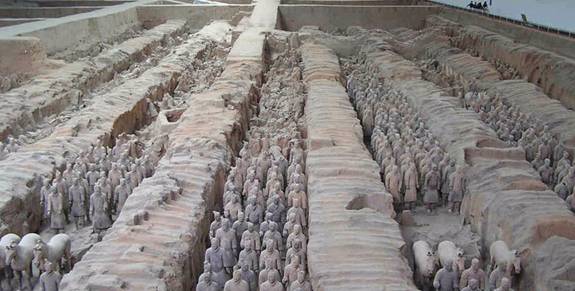
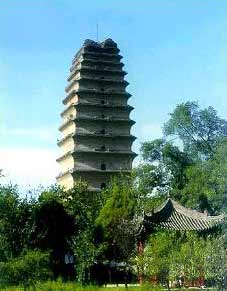 The Small Goose Pagoda is located on the grounds
of the Felicity Temple, and this structure gets its name because
it is smaller than the Big Wild Goose Pagoda, although it has
more stories, higher, and more important in the architectural
history.
The Small Goose Pagoda is located on the grounds
of the Felicity Temple, and this structure gets its name because
it is smaller than the Big Wild Goose Pagoda, although it has
more stories, higher, and more important in the architectural
history.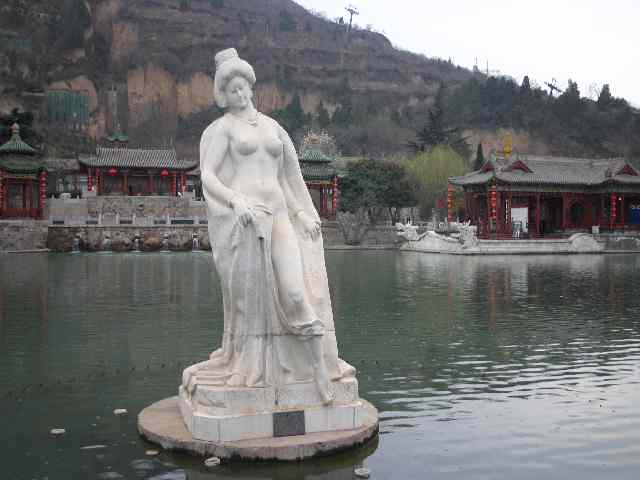 Huanqing Hot Springs are situated at the foot of
Li Mountain, 30 kilometers from Xi'an.
Huanqing Hot Springs are situated at the foot of
Li Mountain, 30 kilometers from Xi'an.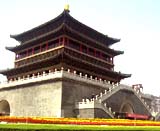 Bell Tower is the most well-preserved and best-known tower among
many ancient cities of China. The Bell Tower was originally built
in the Ying Xi'an Temple in 1384, at the intersection of West
Street and Guangji Street. Then in 1582, it was moved to its present
pivotal position, in the very heart of the city at the junction
of four main streets extending to the east, south, west and north,
for rebuilding and later restorations.
Bell Tower is the most well-preserved and best-known tower among
many ancient cities of China. The Bell Tower was originally built
in the Ying Xi'an Temple in 1384, at the intersection of West
Street and Guangji Street. Then in 1582, it was moved to its present
pivotal position, in the very heart of the city at the junction
of four main streets extending to the east, south, west and north,
for rebuilding and later restorations. 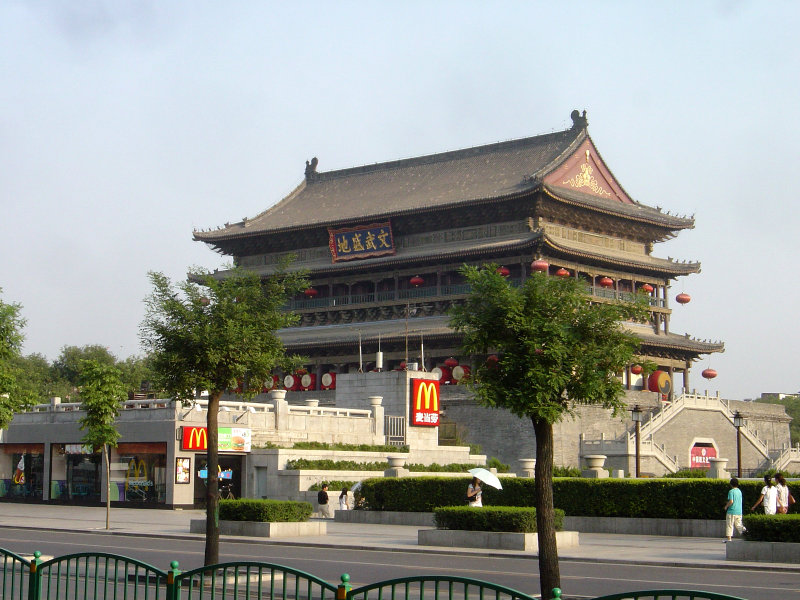 Covering an area of 1924 square meters (0.48 acres)
and with a height of 33 meters (108.3 feet), the Drum Tower is
also a two-storey building with three layers of eaves. The base
of the tower is 52.6 meters (172.6 feet) long, 38 meters wide (124.7
feet) and 7.7 meters (25.3 feet) high. Under the brick-made base
a busy road extends. Visitors can also climb the tower to appreciate
the beautiful landscape of Xi'an. The Drum Tower is smaller than
the Bell Tower. However, it is just southeast of the Great Mosque
and marks the entrance to the Moslem quarter of Xi'an.
Covering an area of 1924 square meters (0.48 acres)
and with a height of 33 meters (108.3 feet), the Drum Tower is
also a two-storey building with three layers of eaves. The base
of the tower is 52.6 meters (172.6 feet) long, 38 meters wide (124.7
feet) and 7.7 meters (25.3 feet) high. Under the brick-made base
a busy road extends. Visitors can also climb the tower to appreciate
the beautiful landscape of Xi'an. The Drum Tower is smaller than
the Bell Tower. However, it is just southeast of the Great Mosque
and marks the entrance to the Moslem quarter of Xi'an. 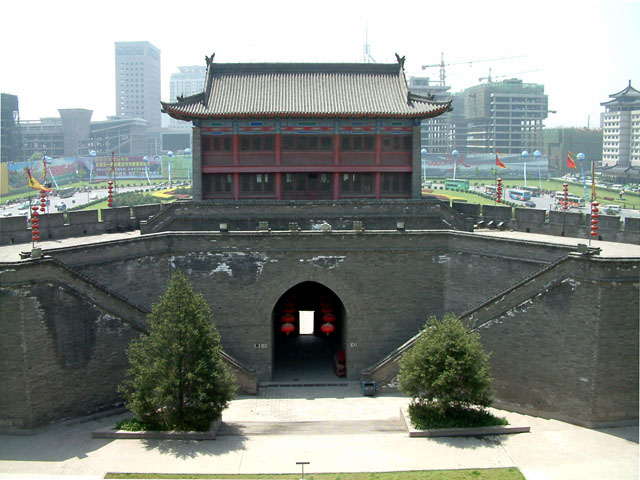 Xi'an is surrounded by a well-preserved City wall
which was re-constructed in the Ming
Dynasty and based in inner imperial palace of Tang Dynasty.
The area in which Xi'an sits is a relatively flat place, making
travel on the wall relatively easy unlike the steep inclines of
the Great Wall. It is also plenty wide enough to rent a bicycle
and cruise along the wall without colliding with others.
Xi'an is surrounded by a well-preserved City wall
which was re-constructed in the Ming
Dynasty and based in inner imperial palace of Tang Dynasty.
The area in which Xi'an sits is a relatively flat place, making
travel on the wall relatively easy unlike the steep inclines of
the Great Wall. It is also plenty wide enough to rent a bicycle
and cruise along the wall without colliding with others. 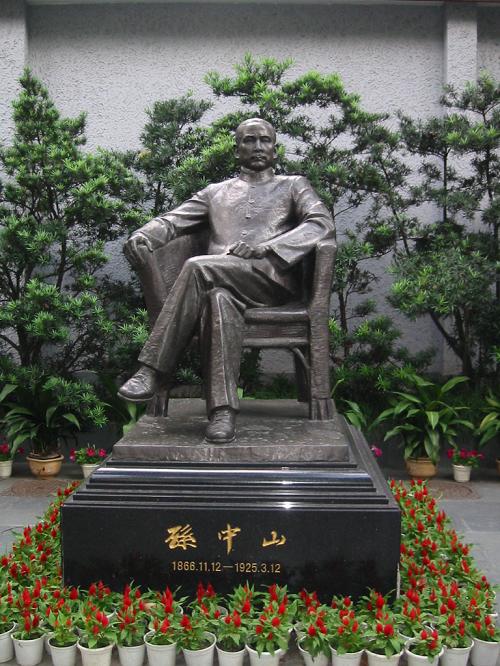 Sun
Yat-sen (1866-1925), the great forerunner of the Chinese democratic
revolution, founder of the Republic of China, and respected contributor
to Chinese modern history lived here with his wife, Soong Ching-ling,
from June 1918 to November 1924. It was here that Dr. Sun accomplished
his renowned masterpieces such as "Doctrines of Sun Wen"
and "Plans of China's Development". It was also here
that he received the representatives of the Communist Party of
China and promoted the first cooperation between the two major
parties in Chinese modern history - the Nationalist Party and
the Communist Party.
Sun
Yat-sen (1866-1925), the great forerunner of the Chinese democratic
revolution, founder of the Republic of China, and respected contributor
to Chinese modern history lived here with his wife, Soong Ching-ling,
from June 1918 to November 1924. It was here that Dr. Sun accomplished
his renowned masterpieces such as "Doctrines of Sun Wen"
and "Plans of China's Development". It was also here
that he received the representatives of the Communist Party of
China and promoted the first cooperation between the two major
parties in Chinese modern history - the Nationalist Party and
the Communist Party.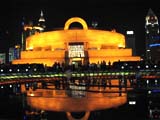 The Shaanxi History Museum in Xi'an has a large collection of
artifacts both modern and ancient.
The Shaanxi History Museum in Xi'an has a large collection of
artifacts both modern and ancient. 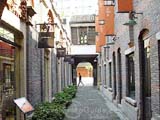 Banpo is an archaeological site located near Xi'an,
China and contains the remains of a Neolithic village.
Banpo is the type-site associated
with Yangshao Culture. Archaeological sites with similarities to
the first phase at Banpo are considered to be part of the Banpo
phase (5000
BC to 4000
BC) of the Yangshao culture. Banpo was excavated from 1954 to 1957 and
covers an area of around 50,000 square meters.
Banpo is an archaeological site located near Xi'an,
China and contains the remains of a Neolithic village.
Banpo is the type-site associated
with Yangshao Culture. Archaeological sites with similarities to
the first phase at Banpo are considered to be part of the Banpo
phase (5000
BC to 4000
BC) of the Yangshao culture. Banpo was excavated from 1954 to 1957 and
covers an area of around 50,000 square meters.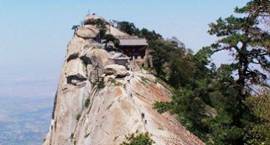 Mount Hua is one of the most visited and steepest
mountains in the country. Mount Hua is located in the Shaanxi
Province, about 100 kilometers east of the city of Xi'an,
near the city Huayin.
Hua was historically the location of several influential Taoist
temples, and was known as a centre for the practise of traditional
Chinese martial arts. In the latter part of 2006,
the mountain was featured in video
advertisements for Snapple green
tea.
Mount Hua is one of the most visited and steepest
mountains in the country. Mount Hua is located in the Shaanxi
Province, about 100 kilometers east of the city of Xi'an,
near the city Huayin.
Hua was historically the location of several influential Taoist
temples, and was known as a centre for the practise of traditional
Chinese martial arts. In the latter part of 2006,
the mountain was featured in video
advertisements for Snapple green
tea.
